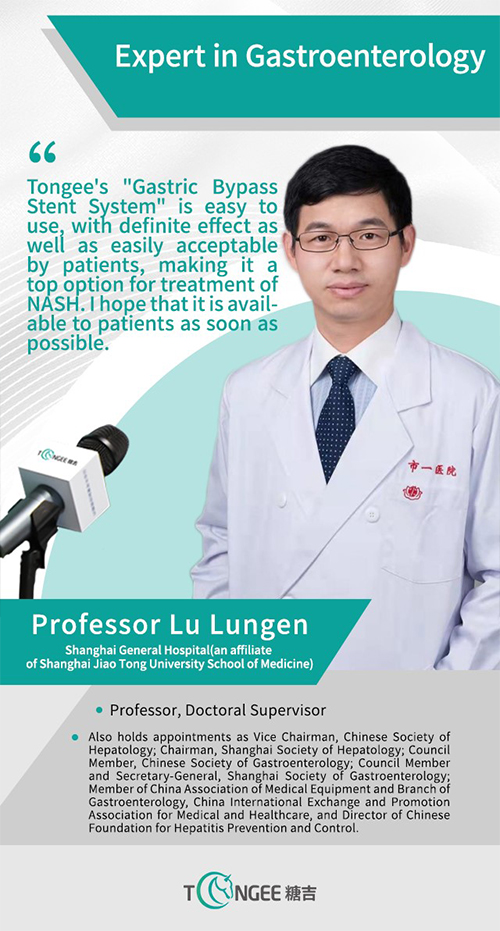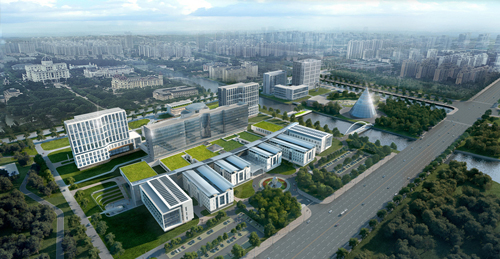New Tongee technology Expected to Benefit Patients with Fatty Liver Disease (FLD) in the View of Prof. Lu Lungen of Shanghai General Hospital
The incidence rate for FLD in China appears to be rising in recent years because of the changes in the general population's dietary habits as a result of better living conditions. According to a study published in Hepatology magazine in 2019, the percentage of FLD patients in China during the past 10 years has increased from 18% to 29.2%, among which, the middle-aged males accounts for the majority.
In fact, many people had been warned of "mild fatty liver" in their medical examination reports but not take it seriously because they see the disease as "unimportant" due to the lack of physical discomfort or could be "reversed". Although at its early stages FLD shows no obvious symptoms, in the long run, it can develop into steatohepatitis, liver fibrosis and liver cancer if left uncontrolled. In severe cases it can be life-threatening.
During an exclusive interview held recently with Prof. Lu Lungen, Director of Gastroenterology in Shanghai General Hospital (affiliated to Shanghai Jiao Tong University School of Medicine), Prof. Lu gave an in-depth explanation on "the long-term impact of fatty liver on physical health" and its scientific medical diagnosis and treatment means and other related topics. Details of the interview are set out below.
Guest-of-honor: Prof. Lungen
Prof. Lu Lungen, Director of Gastroenterology in Shanghai General Hospital (an affiliate of Shanghai Jiao Tong University School of Medicine). He is also a Professor and doctoral supervisor.
●Vice Chairman, Chinese Society of Hepatology, China Medical Association; Chairman, Society of Hepatology, Shanghai Medical Association; Council Member, Chinese Society of Gastroenterology, Chinese Medical Doctor Association; Council Member and Secretary-General, Society of Gastroenterology, Shanghai Medical Doctor Association; Member of China Association of Medical Equipment and Branch of Gastroenterology, China International Exchange and Promotion Association for Medical and Healthcare, as well as Director of Chinese Foundation for Hepatitis Prevention and Control.
●Owner of State Council special government subsidies and inaugural "China's Top Doctor Awards", Outstanding Leader of Academic Discipline in Shanghai and Leading Talent in Shanghai. Holder of 2 invention patents. Obtained 1 National Scientific & Technological Progress Award (Grade II) as the key personnel, 1 Shanghai Scientific & Technological Progress Award (Grade I), 3 Shanghai Scientific & Technological Progress Awards (Grade III), 1 Shanghai Medical Science & Technology Award (Grade II), 2 Chinese Medical Science & Technology Awards (Grade III), 2 Technical Achievement Awards of Ministry of Education (Second-Class) and 1 China Award for Science and Technology in Construction (Second-Class).
●Deputy Chief editor of J Clin Transl Hepatol, Chinese Journal of Hepatology, International Journal of Digestive Diseases, Hepatology and Journal of Practical Hepatology, and member of editorial committee for 10 journals including J Dig Dis, Chinese Journal of Digestion and Chinese Journal of Gastroenterology.
●Editor-in-chief for 7 academic treatises, and participated in the editorial work of more than 30 treatises. He has published more than 600 papers, of which over 130 have been included in SCI. He also organized the compilation of Consensus on Diagnosis and Treatment of Hepatic Fibrosis and Guidelines on the Diagnosis and Treatment of Cholestatic Liver Disease.
●He has chaired 9 major projects of Ministry of Science & Technology under "863", "973", "11th Five Year Plan", "12th Five-Year Plan", "13th Five-Year Plan" and innovation of new drug, as well as 7 projects under National Natural Science Foundation of China and 8 projects for Shanghai Municipal Government.

Q1: Hi, Prof. Lu, from your perspective as a Director of Gastroenterology Department, what is the percentage of patients with FLD among the outpatients? Of these, how many patients suffer from non-alcoholic steatohepatitis (NASH) and NASH with obesity?
Prof. Lu: According to the number of outpatients at Gastroenterology Department, there are relatively more and more patients with FLD, and this number is on an upward trend. Among the outpatients who seek treatment from us, including those with gastrointestinal diseases and those with hepatic, biliary and pancreatic diseases, about 20% of them are suffering from liver diseases. About 80% of patients with liver diseases who seek treatment suffer from NASH (non-alcoholic steatohepatitis). These number are so high due to that these patients are more prone to show abnormal liver biochemical indicators, and many of them also have other metabolism-related diseases like obesity and diabetes.
Q2: Professionally, what are the risks caused by fatty liver to long-term health of patients?
Prof. Lu: The risks imposed by fatty liver to patients' long-term health are mainly reflected in two aspects: 1. Risk of pathological changes to the liver; 2. Risk of pathological changes to organs other than the liver.
With respect to the first one, we all know that it is extremely difficult to treat fatty liver, and it often develop into steatohepatitis, liver fibrosis and even cirrhosis. Some patients even develop into liver cancer which ultimately leads to liver failure or death.;
As for the second one, patients suffering from fatty liver typically have other metabolism-related diseases, such as hyperlipidaemia, diabetes and obesity. All these dangerous factors can cause patients to occur cardiovascular issues, increasing their risk of suffering cardiovascular diseases. In severe cases, they can lead to deaths. Indeed, they are the main cause for death of such patients.
Q3: Clinically, what are main intervention and treatment means for fatty liver since it has such a severe impact on health?
Prof. Lu: At present there are, at home and abroad no approved drugs with specific efficacy against fatty liver. Therefore, the current treatment and intervention means mainly consist of health education, dietary control and exercise therapy. We will also supplement the treatment with other drugs, depending on the actual conditions of individual patient. Nevertheless, these means are often effective for some patients. For the majority of patients, these therapies remains less effective and are far from meeting the needs of clinical doctors and patients. We have been looking for better drugs and treatment means.
Some non-drug based therapies currently known (such as metabolic and bariatric surgeries) and endoscope interventional treatment methods, like Tongee's "gastric bypass stent system", all have an excellent prospect for clinical application.
Q4: Do you think Tongee's "gastric bypass stent system" will become a brand-new treatment means? What do you think about this new therapy?
Prof. Lu: As I mentioned before we have always been looking for new drugs and therapies to treat fatty liver. As for new therapies, I think the following criteria should at least be met: 1. Acceptability by patients; 2. Easy to use; 3. With definite effect; 4. No adverse effects and minimal harm to patients.
In my opinion, Tongee's "gastric bypass stent system" intervention surgery can meet all the requirements above. It is a safe and effective treatment for fatty liver and is beneficial for improving patients' living quality and extending their lifetime. I wish to see its use in clinical treatment for NASH and other metabolism-related diseases, so as to bring these patients a new hope.
Q5: To which type of fatty liver patients will you recommend "gastric bypass stent system" for clinical treatment? Are you willing to share this new therapy in your future academic conferences and meetings?
Prof. Lu: Judging by its therapeutic principles, mode of implementation and course of treatment, "gastric bypass stent system" is a safe and effective new technology and means for treating fatty liver and diseases associated with metabolism. It is promising and suitable for patients with unsatisfactory effect with drugs and normal dietary and exercise treatments.
For the moment, the use of "gastric bypass stent system" for treatment of metabolism-related diseases is reported mostly by media. It appears to be an excellent therapy, safe and effective. I also hope that other doctors and patients would learn about the new technology and treatment means, so as to help us treat FLD in a better way.
Prof. Lu: As I mentioned before we have always been looking for new drugs and therapies to treat fatty liver. As for new therapies, I think the following criteria should at least be met: 1. Acceptability by patients; 2. Easy to use; 3. With definite effect; 4. No adverse effects and minimal harm to patients.
Conclusion:
In recent years, FLD has become a common liver disease which is closely related to metabolic syndromes like obesity and Type II diabetes. It is now an issue of public health, affecting the health of people all over the world. As said by Prof. Lu, there is no approved drug, domestically or internationally, for treatment of FLD, and any intervention by changing lifestyle to improve the life of patients with metabolic syndrome and other complications is less effective than ideal. Therefore, doctors are constantly seeking new drugs and means to treat FLD clinically.
The emergence of a new technology such as "gastric bypass stent system" which is acceptable to patients, easy to use and with definite effect doubtlessly deserves greater attention of patients and general public. As an advanced scientific treatment method and with proven clinical study results, it brings a new hope to the patients suffering from FLD and diseases relating to metabolism.
As for the pathogenesis of FLD, we still need to do a lot of researches. We will continue to learn more about it, as well as follow the R&D of emerging technologies and drugs and their clinical results. We hope that there will be more new and effective therapies to alleviate existing difficulty in treating FLD.
●Shanghai General Hospital (an affiliate of Shanghai Jiao Tong University School of Medicine)


Built in 1864, Shanghai General Hospital, call as The General Hospital in history, was at that time the largest western medicine hospital in China. It is also one of the earliest general hospitals in China. Today, Shanghai General Hospital operates in two locations namely Hongkou and Sungkiang. It also has taken over the Jiangqiao Hospital in Jiading. During the COVID-19 pandemic, the hospital was the first to send its team of medical workers and experts to Wuhan, many of whom are CCP members. They all have been commended by the Party, the country and Shanghai Municipal Government. The hospital was honored in the 6th "National Civilized Unit" and also won the "Model Unit of Red Cross Society of China" honor. It also received A++ rating among all Grades 1/2/3 public hospitals in China, putting it 12th among 2,413 Grades 1/2/3 public hospitals nationally and 3rd in Shanghai.
